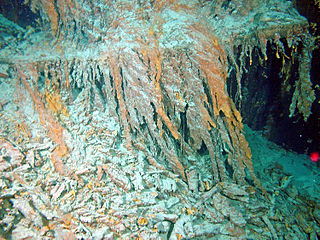The Aquificota phylum is a diverse collection of bacteria that live in harsh environmental settings. The name Aquificota was given to this phylum based on an early genus identified within this group, Aquifex, which is able to produce water by oxidizing hydrogen. They have been found in springs, pools, and oceans. They are autotrophs, and are the primary carbon fixers in their environments. These bacteria are Gram-negative, non-spore-forming rods. They are true bacteria as opposed to the other inhabitants of extreme environments, the Archaea.
Parvularcula is a genus of marine bacteria.
The Aurantimonadaceae are a small family of marine bacteria.
Fulvimarina is a genus of bacteria from the family of Aurantimonadaceae.

Sulfur-reducing bacteria are microorganisms able to reduce elemental sulfur (S0) to hydrogen sulfide (H2S). These microbes use inorganic sulfur compounds as electron acceptors to sustain several activities such as respiration, conserving energy and growth, in absence of oxygen. The final product of these processes, sulfide, has a considerable influence on the chemistry of the environment and, in addition, is used as electron donor for a large variety of microbial metabolisms. Several types of bacteria and many non-methanogenic archaea can reduce sulfur. Microbial sulfur reduction was already shown in early studies, which highlighted the first proof of S0 reduction in a vibrioid bacterium from mud, with sulfur as electron acceptor and H
2 as electron donor. The first pure cultured species of sulfur-reducing bacteria, Desulfuromonas acetoxidans, was discovered in 1976 and described by Pfennig Norbert and Biebel Hanno as an anaerobic sulfur-reducing and acetate-oxidizing bacterium, not able to reduce sulfate. Only few taxa are true sulfur-reducing bacteria, using sulfur reduction as the only or main catabolic reaction. Normally, they couple this reaction with the oxidation of acetate, succinate or other organic compounds. In general, sulfate-reducing bacteria are able to use both sulfate and elemental sulfur as electron acceptors. Thanks to its abundancy and thermodynamic stability, sulfate is the most studied electron acceptor for anaerobic respiration that involves sulfur compounds. Elemental sulfur, however, is very abundant and important, especially in deep-sea hydrothermal vents, hot springs and other extreme environments, making its isolation more difficult. Some bacteria – such as Proteus, Campylobacter, Pseudomonas and Salmonella – have the ability to reduce sulfur, but can also use oxygen and other terminal electron acceptors.
Flammeovirgaceae is a family of bacteria.
In taxonomy, Stappia is a genus of the Hyphomicrobiales. Some members of the genus oxidize carbon monoxide (CO) aerobically. Stappia indica is a diatom associated bacterium which is known to inhibit the growth of diatoms such as Thalassiosira pseudonana.

Spirochaeta americana is a single-celled extremophile. This haloalkaliphilic and obligately anaerobic bacterium can be found in the highly alkaline, salty, deep waters of California's Mono Lake.
Cohaesibacter gelatinilyticus is a gram-negative bacteria from the genus of Cohaesibacter which was isolated from surface of coastal seawater from the east coast of Korea.

Halomonas titanicae is a gram-negative, halophilic species of bacteria which was isolated in 2010 from rusticles recovered from the wreck of the RMS Titanic. It has been estimated by Henrietta Mann, one of the researchers that first isolated it, that the action of microbes like Halomonas titanicae may bring about the total deterioration of the Titanic by 2030. While the bacteria have been identified as a potential danger to oil rigs and other man-made objects in the deep sea, they also have the potential to be used in bioremediation to accelerate the decomposition of shipwrecks littering the ocean floor.
Alcanivorax pacificus is a pyrene-degrading marine gammaproteobacterium. It is of the genus Alcanivorax, a group of marine bacteria known for degrading hydrocarbons. When originally proposed, the genus Alcanivorax comprised six distinguishable species. However, A. pacificus, a seventh strain, was isolated from deep sea sediments in the West Pacific Ocean by Shanghai Majorbio Bio-pharm Technology Co., Ltd. in 2011. A. pacificus’s ability to degrade hydrocarbons can be employed for cleaning up oil-contaminated oceans through bioremediation. The genomic differences present in this strain of Alcanivorax that distinguish it from the original consortium are important to understand to better utilize this bacteria for bioremediation.
Fulvimarina pelagi is a Gram-negative, strictly aerobic, non-motile bacteria from the genus of Fulvimarina which was isolated from sea water from the western Sargasso Sea.
Flammeovirga is a Gram-negative, aerobic, non-spore-forming and chemoorganotrophic genus of bacteria in the family Flammeovirgaceae which occur in marine environments.
Ponticoccus marisrubri is a Gram-negative, aerobic, moderately halophilic and non-motile bacterium from the genus Ponticoccus which has been isolated from seawater from the Erba Deep from the Red Sea.

Deferrisoma camini is a moderately thermophilic and anaerobic bacterium from the genus of Deferrisoma which has been isolated from a deep-sea hydrothermal vent from the Eastern Lau Spreading Centre in the Pacific Ocean.
Coprothermobacter platensis is a species of moderately thermophilic and strictly anaerobic bacterium belonging to the family Coprothermobacteraceae within the phylum Coprothermobacterota.
The Temperatibacteraceae are a family of bacteria.
Minwuia thermotolerans is a species of bacteria.
Acidimangrovimonas indica is a Gram-negative, strictly aerobic, chemoheterotrophic and motile bacterium from the genus of Acidimangrovimonas which has been isolated from a deep-sea hydrothermal vent from the Southwest Indian Ridge in China.



